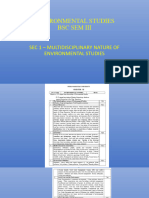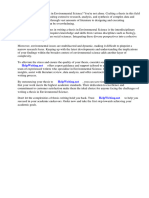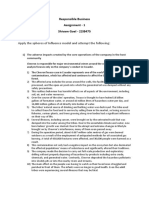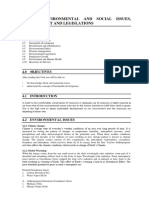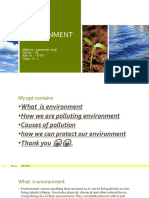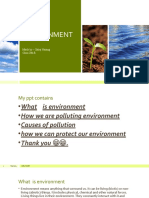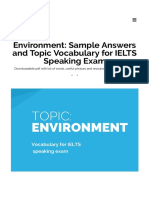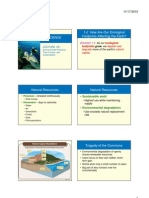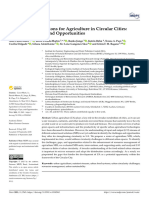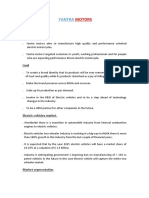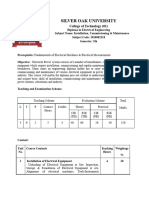0 ratings0% found this document useful (0 votes)
83 viewsChapter 6-Managing Our Changing Environment
Chapter 6-Managing Our Changing Environment
Uploaded by
wahyu pradivaIT WILL BE HELPFUL FOR YOUR SOCIAL STUDIES TEST/EXAM
Copyright:
© All Rights Reserved
Available Formats
Download as PPT, PDF, TXT or read online from Scribd
Chapter 6-Managing Our Changing Environment
Chapter 6-Managing Our Changing Environment
Uploaded by
wahyu pradiva0 ratings0% found this document useful (0 votes)
83 views28 pagesIT WILL BE HELPFUL FOR YOUR SOCIAL STUDIES TEST/EXAM
Original Title
Chapter 6-Managing Our Changing Environment (1)
Copyright
© © All Rights Reserved
Available Formats
PPT, PDF, TXT or read online from Scribd
Share this document
Did you find this document useful?
Is this content inappropriate?
IT WILL BE HELPFUL FOR YOUR SOCIAL STUDIES TEST/EXAM
Copyright:
© All Rights Reserved
Available Formats
Download as PPT, PDF, TXT or read online from Scribd
Download as ppt, pdf, or txt
0 ratings0% found this document useful (0 votes)
83 views28 pagesChapter 6-Managing Our Changing Environment
Chapter 6-Managing Our Changing Environment
Uploaded by
wahyu pradivaIT WILL BE HELPFUL FOR YOUR SOCIAL STUDIES TEST/EXAM
Copyright:
© All Rights Reserved
Available Formats
Download as PPT, PDF, TXT or read online from Scribd
Download as ppt, pdf, or txt
You are on page 1of 28
CHAPTER 6
Managing Our Changing Environment
Copyright © 2006-2011 Marshall Cavendish International (Singapore) Pte. Ltd.
Learning Outcomes
You Will Learn:
• to explain the reasons for the constantly changing
environment
• to describe the impact of human activities on the
environment at local, regional and global scales
• to explain the role people play in managing the
changing environment
• to justify the need to protect and conserve the
environment
Copyright © 2006-2011 Marshall Cavendish International (Singapore) Pte. Ltd.
Copyright © 2006-2011 Marshall Cavendish International (Singapore) Pte. Ltd.
Lead-in: For Better or For Worse?
(Suggested Answers)
1. The activity in the photograph
shows deforestation.
• The physical environment would
likely be changed into a human
environment.
• We clear forests for land to build
urban settlements like cities and
roads, for useful resources like
timber and for agriculture.
Copyright © 2006-2011 Marshall Cavendish International (Singapore) Pte. Ltd.
Lead-in: For Better or For Worse?
(Suggested Answers)
2. These changes have both positive and
negative impacts.
• Clearing forests enables us to expand our
cities, land transport networks and improve
our lives economically and socially by raising
our standard of living (more space and less
congestion).
• However, deforestation can cause us to
permanently lose the biodiversity in the forests.
• Can you think of examples where biodiversity
in the forests can be used to improve our
lives?
Copyright © 2006-2011 Marshall Cavendish International (Singapore) Pte. Ltd.
TASK
•Brainstorm and suggest three
ways in which human beings
have changed the
environment
Copyright © 2006-2011 Marshall Cavendish International (Singapore) Pte. Ltd.
New roads
MRT station
Transport
Changes in the
neighbourhood/
community
Copyright © 2006-2011 Marshall Cavendish International (Singapore) Pte. Ltd.
Copyright © 2006-2011 Marshall Cavendish International (Singapore) Pte. Ltd.
Copyright © 2006-2011 Marshall Cavendish International (Singapore) Pte. Ltd.
Lead-in: For Better or For Worse?
(Suggested Answers)
3. We can help protect and conserve
forests by practising the 3Rs — Reduce,
Reuse and Recycle.
• Can you think of some examples?
• Refuse, Repair
Copyright © 2006-2011 Marshall Cavendish International (Singapore) Pte. Ltd.
Lead-in: Using the Earth’s Resources
Extension Activity
• We extract mineral resources, like coal, iron,
copper and aluminum, from the Earth’s crust and
process them into useful materials to meet our
needs.
• In doing so, we make enormous changes to the
physical environment. It is also important to realise
that the environmental effects of using these
resources extend beyond its mining stage of
extraction to its eventual use.
Copyright © 2006-2011 Marshall Cavendish International (Singapore) Pte. Ltd.
Our Constantly Changing Environment
• We constantly change our environment as we find
means to survive and make our lives more comfortable.
• As the world’s population continues to grow rapidly, the
need for food, housing, amenities and other necessities
will increase as well. In order to meet these needs, land
has to be cleared for urban settlements and agriculture.
As a result, we often make changes to the environment.
• Although these changes benefit us in many ways, they
have adverse impacts on the environment.
Cars and factories emit
Forests are cleared to make way for pollutants into the air.
Copyright © 2006-2011 Marshall Cavendish International (Singapore) Pte. Ltd.
urban settlements and agriculture.
Our Constantly Changing Environment
Growing world population
• Today, the world’s population stands at some 7.1 billion
people. By 2050, it is expected to reach 9 billion.
• The rapid growth of the world’s population will cause an
increase in the demand for natural resources. When
more resources are consumed by people, more rubbish
is generated.
• As Singapore’s population continues to grow, more
waste is generated. To meet the future increasing
demand for incineration of waste, more incineration
plants are being built.
Waste awaiting incineration in an
incineration plant. Incineration
produces a highly toxic waste
Copyright © 2006-2011 Marshall Cavendish International (Singapore) Pte. Ltd.
material known as fly ash.
Our Constantly Changing Environment
Advances in technology
• As technology advances, the rate in which the
environment changes also increases.
• For instance, today’s farmers depend on
machinery like tractors and combine harvesters
to cultivate large areas of land for agriculture
within a shorter period of time and with less
manpower.
Copyright © 2006-2011 Marshall Cavendish International (Singapore) Pte. Ltd.
Our Constantly Changing Environment
Advances in technology
• The pace of industrialisation has also increased due to
advances in technology. With automation in factories,
mass production of goods is possible. The integration of
global transport networks has made it easier to transport
goods between cities and countries.
• For example, the invention of container ships has greatly
facilitated the growth of industrialisation and global
international trade.
The integration of rail and sea transport
modes has made the transportation of
goods and cargo more efficient.
Copyright © 2006-2011 Marshall Cavendish International (Singapore) Pte. Ltd.
Impact of Human Activities on the
Environment
Problems caused by human activities
• Pollution is the introduction of substances into the
environment such that it results in unpleasant or
damaging effects to the environment.
• Global warming is the increase in air temperatures
throughout the world.
• Ozone depletion is the gradual destruction of the
ozone layer caused mainly by the release of
chlorofluorocarbons (CFCs) into the atmosphere.
Copyright © 2006-2011 Marshall Cavendish International (Singapore) Pte. Ltd.
Major sources and health and
environmental effects of air pollutants
Major Health Effects Environmental
Sources effects
Carbon Vehicles Headaches and
monoxi fatigue, especially
de in people with
weak
cardiovascular
health
Lead Vehicles, Accumulates in Kills
(burning bloodstream over fish/animals
leaded time; damages
gasoline) nervous system
Impact of Human Activities on the
Environment
Impact of human activities at various scales
• An environmental impact at a local scale affects
only the area where a problem occurred.
• For example, studies have shown that waste
disposed at landfills can contaminate groundwater
and nearby water bodies.
Most landfills release
greenhouse gases like
methane and carbon
dioxide and eventually leak
hazardous chemicals.
Copyright © 2006-2011 Marshall Cavendish International (Singapore) Pte. Ltd.
Impact of Human Activities on the
Environment
Impact of human activities at various scales
• An environmental impact at a regional scale
affects a few countries located in the same part of
the world.
• An example is the occasional haze that engulfs
parts of Southeast Asia caused by smoke from
widespread burning of forests and agricultural
plantations in Indonesia.
• Countries like Singapore, Malaysia and Thailand are
affected by haze.
Haze covering a cityscape
Copyright © 2006-2011 Marshall Cavendish International (Singapore) Pte. Ltd.
Impact of Human Activities on the
Environment
Impact of human activities at various scales
• An environmental impact at a global scale affects the
whole world. The impact of human activities is the greatest
at the global scale.
• Changes to the global atmosphere will result in global
warming and ozone depletion which affect all life on
Earth.
• Global warming will cause ice and snow-covered areas in
the Poles to melt and cause sea-levels to rise. As a result,
low-lying countries like Bangladesh are more susceptible
to flooding.
Coastal cities like Cancun,
Mexico, are susceptible to
flooding as global sea levels
rise due to global warming.
Copyright © 2006-2011 Marshall Cavendish International (Singapore) Pte. Ltd.
Impact of Human Activities on the
Environment
Impact of human activities at various scales
• Ozone depletion damages crops and phytoplankton
in the oceans, and will cause increased incidence of
skin cancer and eye cataracts in people.
Source: NASA Observatory
Ozone depletion over the
Arctic region from 1981–
Copyright © 2006-2011 Marshall Cavendish International (Singapore) Pte. Ltd.
1999.
Impact of Human Activities on the
Environment
Impact of human activities at various scales
• As the global impacts of global warming and
ozone depletion are catastrophic, it is necessary
for a worldwide coordinated effort where
individuals and national, regional and
international organisations work towards
minimising these impacts.
Copyright © 2006-2011 Marshall Cavendish International (Singapore) Pte. Ltd.
The need to Protect and Conserve
the Environment
Managing the environment to meet our needs
• With a growing world population and advances in
technology, the use of natural resources is
increasing.
• We have to manage the scarce resources wisely to
meet our needs.
Copyright © 2006-2011 Marshall Cavendish International (Singapore) Pte. Ltd.
Impact of Human Activities on the
Environment
Managing the consequences of our actions
• Problems such as pollution, global warming and
ozone depletion result as we change the
environment to meet our needs.
• As all living things on the Earth are interdependent,
ignoring these problems will precipitate a global
environmental crisis which will have adverse
environmental consequences.
Copyright © 2006-2011 Marshall Cavendish International (Singapore) Pte. Ltd.
Impact of Human Activities on the
Environment
Managing the consequences of our actions
• Hence, we need to practise environmental
conservation where we use the Earth’s resources
carefully to ensure that there are enough natural
resources left for future use(sustainability), and
damage to the environment is kept to a minimum.
Copyright © 2006-2011 Marshall Cavendish International (Singapore) Pte. Ltd.
Skills Builder: Suggested Answers
1. Industrialisation, agriculture, mining, deforestation, the
damming of the reservoir and forest fires are some of the
human activities that can be identified in the picture.
2.
(a) 1. Factories release greenhouse gases into the
atmosphere and cause global warming.
2. Discharging untreated industrial waste into the
Industrialisation river causes water pollution.
(b) For (1), the impact is global. For (2), the impact
may be local or regional. (Accept plausible
answers.)
(a) Harmful substances in the pesticides from crop dusting
may find their way and accumulate in the food
Agriculture chains of living things. This may cause undesirable
health effects.
(b) Local
Copyright © 2006-2011 Marshall Cavendish International (Singapore) Pte. Ltd.
Skills Builder: Suggested Answers
2.
(a) Mining (e.g. coal) causes land disturbance, soil
erosion, air and water pollution. For example, mining
Mining can result in the emission of toxic chemicals into the
atmosphere.
(b) Local
(a) Deforestation alters the climate of the affected area
and causes soil erosion. Living things also lose their
Deforestation
habitats.
(b) Local
(a) The dam allows water to accumulate in the
reservoir behind the dam and controls the water flow
in the river downstream. The migration and spawning
Dam
of some fish may be affected. Downstream cropland
may be deprived of nutrient-rich silt.
(b) Local or regional
Copyright © 2006-2011 Marshall Cavendish International (Singapore) Pte. Ltd.
Skills Builder: Suggested Answers
2.
(a) The burning of forests, either deliberate or accidental,
releases smoke into the air and causes air pollution.
Forest fires
Haze may occur.
(b) Local or regional
3. (a) People have built solar power plants to produce
electricity from renewable solar energy. Solar power plants
do not release greenhouse gas emissions like carbon
dioxide but are costly.
(b) People can help conserve and protect the
environment by reducing dependency on fossil fuels and
thus decreasing greenhouse gas emissions, treating
industrial waste before discharging it into rivers and seas,
practising reforestation and reducing synthetic pesticide
use, etc. (Accept any plausible answers.)
Copyright © 2006-2011 Marshall Cavendish International (Singapore) Pte. Ltd.
You might also like
- Duct Systems Design GuideDocument19 pagesDuct Systems Design Guiderpercor0% (1)
- Miller 15e Ch01Document43 pagesMiller 15e Ch01ChocochipNo ratings yet
- Sec 1 - Environmental StudiesDocument36 pagesSec 1 - Environmental Studiesmecete8514No ratings yet
- Environmental Thesis PDFDocument5 pagesEnvironmental Thesis PDFDaniel Wachtel100% (1)
- #PULOTKALAT/Solid Waste Disposal and The Cleanliness of SurroundingsDocument12 pages#PULOTKALAT/Solid Waste Disposal and The Cleanliness of Surroundingsgndmhj,hj,hNo ratings yet
- FinalDocument3 pagesFinalchristian obligadoNo ratings yet
- CV1691 Environmental Management: Reference BooksDocument18 pagesCV1691 Environmental Management: Reference BooksArjit GoswamiNo ratings yet
- Saving Environment: Made By: Manthan Patel Class:9-C Roll No.-22Document10 pagesSaving Environment: Made By: Manthan Patel Class:9-C Roll No.-22Manthan PatelNo ratings yet
- Thesis Environmental ScienceDocument6 pagesThesis Environmental Sciencerebeccaharriscary100% (1)
- ShivamGoel ResponsibleBusiness AssignmentDocument2 pagesShivamGoel ResponsibleBusiness AssignmentSHIVAM GOEL 22IB475No ratings yet
- Towards A Brighter Ecological FutureDocument42 pagesTowards A Brighter Ecological FutureMa Sharmaine JaboneroNo ratings yet
- Environmental Planning & Practice: Unit 1: IntroductionDocument26 pagesEnvironmental Planning & Practice: Unit 1: Introductionsehrish khawerNo ratings yet
- Unit-4 EVSDocument15 pagesUnit-4 EVSdivyanshraj2030No ratings yet
- (ITC TOPIC) World and The Environment (Group 4)Document19 pages(ITC TOPIC) World and The Environment (Group 4)rearismooreNo ratings yet
- On Environment: Made by - Paramveer Singh Roll No. - 33 Admno. - 41811 Class - 9 - LDocument7 pagesOn Environment: Made by - Paramveer Singh Roll No. - 33 Admno. - 41811 Class - 9 - LHenson JoyNo ratings yet
- 1 - Environmental Sustainability and Human Values-2Document50 pages1 - Environmental Sustainability and Human Values-2harryson zylNo ratings yet
- On EnvironmentDocument7 pagesOn EnvironmentSahej NarangNo ratings yet
- Sustainability in EngineeringDocument7 pagesSustainability in EngineeringKuldeep ThakurNo ratings yet
- ISO 14001 Environmental AwarenessDocument34 pagesISO 14001 Environmental AwarenessYU TAONo ratings yet
- My Analysis Report: Global Environmental Issues Deevena 6ADocument9 pagesMy Analysis Report: Global Environmental Issues Deevena 6Aapi-326239284No ratings yet
- Environmental Awreness and ProtectionDocument3 pagesEnvironmental Awreness and ProtectionJAYSON BAUTISTANo ratings yet
- Environmental ProblemDocument1 pageEnvironmental ProblemJeremia MsofuNo ratings yet
- English FileDocument4 pagesEnglish Fileks4280446No ratings yet
- Socio-Ecological Problems: Green Marketing Management DMA 557Document24 pagesSocio-Ecological Problems: Green Marketing Management DMA 557eklwgnnwlgNo ratings yet
- Sustainability Ecosystem & Its ServicesDocument31 pagesSustainability Ecosystem & Its Servicestengkuhafizudin96No ratings yet
- Grade 7 Ste 1Document42 pagesGrade 7 Ste 1leahbobbinsxNo ratings yet
- Case Studies On Environment and Society Part-IDocument7 pagesCase Studies On Environment and Society Part-INamrata ChhabraNo ratings yet
- CEBA Fact SheetDocument2 pagesCEBA Fact SheetazeveNo ratings yet
- Waste Management SGDocument11 pagesWaste Management SGDurwanNo ratings yet
- Environmental Awareness OrganizationsDocument6 pagesEnvironmental Awareness OrganizationsdjisthecoolNo ratings yet
- UNITIMergedDocument111 pagesUNITIMergedmalikanuj0151No ratings yet
- 1592546992Document16 pages1592546992goutamajit036No ratings yet
- Lecture 2 Chapter 1Document25 pagesLecture 2 Chapter 1bob.bobson.bobson.bob123No ratings yet
- The Multidisciplinary Nature of Environmental StudiesDocument22 pagesThe Multidisciplinary Nature of Environmental StudiesStuti MadaanNo ratings yet
- Module 5 Environmental Protection EducationDocument26 pagesModule 5 Environmental Protection EducationmyorablueNo ratings yet
- CH 7 Environment Sustainable DevelopmentDocument14 pagesCH 7 Environment Sustainable DevelopmentD. Naarayan NandanNo ratings yet
- Safayet - 181020031 - Enviromental Issues - FinalDocument6 pagesSafayet - 181020031 - Enviromental Issues - Finalsafayet rahmanNo ratings yet
- Sorsogon State College: Republic of The PhilippinesDocument3 pagesSorsogon State College: Republic of The PhilippinesCristine Mae E. ArevaloNo ratings yet
- NSTP Group 2 ReportingDocument27 pagesNSTP Group 2 ReportingcliermanguiobNo ratings yet
- Cultural Services: Top 10 Environmental Issues Around The GlobeDocument1 pageCultural Services: Top 10 Environmental Issues Around The GlobeVICTORIANo ratings yet
- Exposition Air Pollution Team 1Document10 pagesExposition Air Pollution Team 1Cyn SoberanoNo ratings yet
- World Environment Day 2010: Many Species. One Planet. One FutureDocument16 pagesWorld Environment Day 2010: Many Species. One Planet. One FutureDeprizon SyamsunurNo ratings yet
- On "Environment Protection - 4R"Document12 pagesOn "Environment Protection - 4R"INFINITY LOOPNo ratings yet
- LESSON 8 Environmental IssuesDocument21 pagesLESSON 8 Environmental IssuesJean DoriaNo ratings yet
- WCFS2019: Proceedings of the World Conference on Floating SolutionsFrom EverandWCFS2019: Proceedings of the World Conference on Floating SolutionsNo ratings yet
- 7 Business and EcologyDocument24 pages7 Business and Ecologyklee042697No ratings yet
- CSR Project ProposalDocument15 pagesCSR Project ProposalShenali NupehewaNo ratings yet
- Environment - Sample Answers and Topic Vocabulary For IELTS Speaking Exam - TheTestTakerDocument31 pagesEnvironment - Sample Answers and Topic Vocabulary For IELTS Speaking Exam - TheTestTakerAlejandro Sosa De GreefNo ratings yet
- Human Activity Impact On EnvironmentDocument29 pagesHuman Activity Impact On EnvironmentHemant KushwahNo ratings yet
- Environmental Economics - Module 1Document21 pagesEnvironmental Economics - Module 1meghagoyal4801No ratings yet
- Module 5: Environmental EducationDocument61 pagesModule 5: Environmental EducationChristlly LamyananNo ratings yet
- Introduction To Environmental ScienceDocument37 pagesIntroduction To Environmental ScienceKieth Zamira RomanoNo ratings yet
- 9 Environment and Sustainable DevelopmentDocument10 pages9 Environment and Sustainable Developmentaarushi.aggarwal456No ratings yet
- Earth and Environmental Science Quarter 4 MELC 3 Dweyne Loren O. Riomalos Grade 7 DiophantusDocument5 pagesEarth and Environmental Science Quarter 4 MELC 3 Dweyne Loren O. Riomalos Grade 7 DiophantusDoren MagdamoNo ratings yet
- Waste Management in AustraliaDocument17 pagesWaste Management in AustraliaMohd NoorNo ratings yet
- Teaching StrategiesDocument42 pagesTeaching StrategiesMat TjsNo ratings yet
- Green BuildingDocument32 pagesGreen BuildingMusz AdtrackNo ratings yet
- Environmental Protection: Simple Solution To Lessen Environmental DegradationDocument30 pagesEnvironmental Protection: Simple Solution To Lessen Environmental DegradationmariniabrahanNo ratings yet
- National Service Traning ProgramDocument37 pagesNational Service Traning ProgramSandra LacsaNo ratings yet
- ENVI SCI Lecture 1BDocument6 pagesENVI SCI Lecture 1BMary Rose SioNo ratings yet
- Supplemental Guide for Studies In Environmental Management and Safety: A California FocusFrom EverandSupplemental Guide for Studies In Environmental Management and Safety: A California FocusNo ratings yet
- 834 Units: Clifton VillasDocument2 pages834 Units: Clifton VillasAliNo ratings yet
- IC Engine BayyeeDocument2 pagesIC Engine Bayyeebirbirsabetee27100% (1)
- Valvula de Control ParkingDocument5 pagesValvula de Control ParkingmartinaguilarespinoNo ratings yet
- Plano Sistema de LevanteDocument1 pagePlano Sistema de LevanteRodolfoNo ratings yet
- Fracture Toughness of UPVC Pipe PaperDocument5 pagesFracture Toughness of UPVC Pipe PaperMZeeshanAkramNo ratings yet
- Engine Electrical PDFDocument177 pagesEngine Electrical PDFManuel Fernandez0% (1)
- Water 13 02565 v3Document22 pagesWater 13 02565 v3ranersNo ratings yet
- Yantra Motors Quick IntroductionDocument4 pagesYantra Motors Quick IntroductionrvsNo ratings yet
- Datasheet - HK pm24024-110 4671240Document2 pagesDatasheet - HK pm24024-110 4671240amonNo ratings yet
- There Are 8 Basic Types of Fan Wheels PDFDocument3 pagesThere Are 8 Basic Types of Fan Wheels PDFAnonymous bHh1L1No ratings yet
- RDM - HSB-3Document2 pagesRDM - HSB-3jeneveuxpasNo ratings yet
- APA - Engineered Wood Construction GuideDocument20 pagesAPA - Engineered Wood Construction GuidePatrice AudetNo ratings yet
- Mid IEC Lec01 To Lec03Document37 pagesMid IEC Lec01 To Lec03ahmed jubayerNo ratings yet
- PDS-0003 - FilterEx Exhaust Gas SystemDocument2 pagesPDS-0003 - FilterEx Exhaust Gas SystemErollfaizal ErollfaizalNo ratings yet
- 0330 572 Pve B 125 00Document122 pages0330 572 Pve B 125 00RohitNo ratings yet
- Non Conventional Energy Resources by G S Sawhney B00k7ygm24Document5 pagesNon Conventional Energy Resources by G S Sawhney B00k7ygm24Karan ChanchlaniNo ratings yet
- Hist FORM TWODocument60 pagesHist FORM TWOCarol SoiNo ratings yet
- ANDIG1Document23 pagesANDIG1Manolo MuñozNo ratings yet
- Monolux® - Technical Data Sheet - EnglishDocument2 pagesMonolux® - Technical Data Sheet - EnglishИлия ГеоргиевNo ratings yet
- 6 FM 175Document2 pages6 FM 175wajidiftikharNo ratings yet
- FMDS0823Document30 pagesFMDS0823thongtn2007No ratings yet
- 104 - EarthingDocument70 pages104 - Earthingradulescuandrei100No ratings yet
- Physics Investigatory Project Class 12Document15 pagesPhysics Investigatory Project Class 12Harshvardhan More40% (5)
- HG 520 ManualDocument71 pagesHG 520 ManualwellyalzabenNo ratings yet
- 2 N 7000Document6 pages2 N 7000zhlikhonNo ratings yet
- Electrified Cracking ECMDocument12 pagesElectrified Cracking ECMDiego MaportiNo ratings yet
- InstallationCommissioning MaintenanceDocument5 pagesInstallationCommissioning MaintenanceER Mukesh ThakurNo ratings yet
- Endress-Hauser Proline Promag P 300 5P3B ENDocument5 pagesEndress-Hauser Proline Promag P 300 5P3B ENDielon PatikNo ratings yet
- Group Assignment: Shell and Petronas Gas BerhadDocument34 pagesGroup Assignment: Shell and Petronas Gas Berhadirfan_handaru100% (2)


